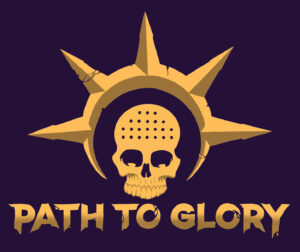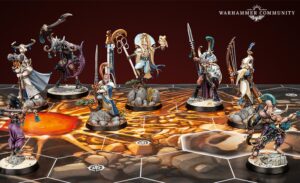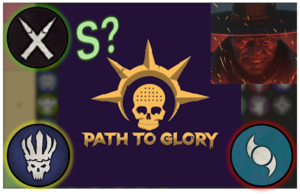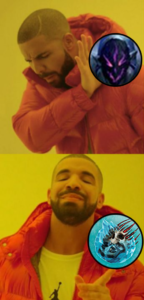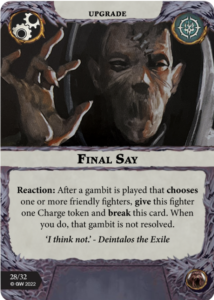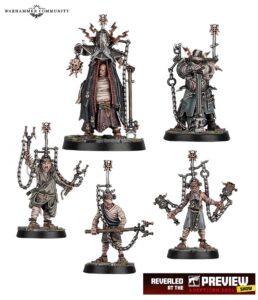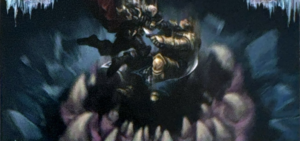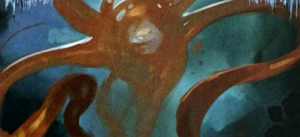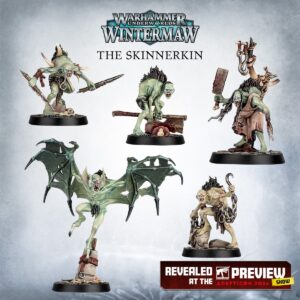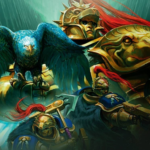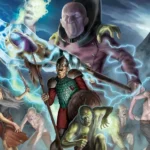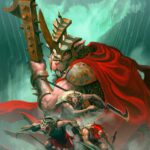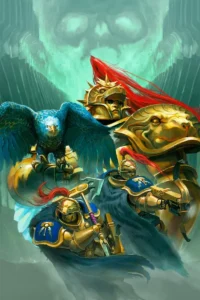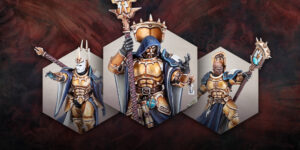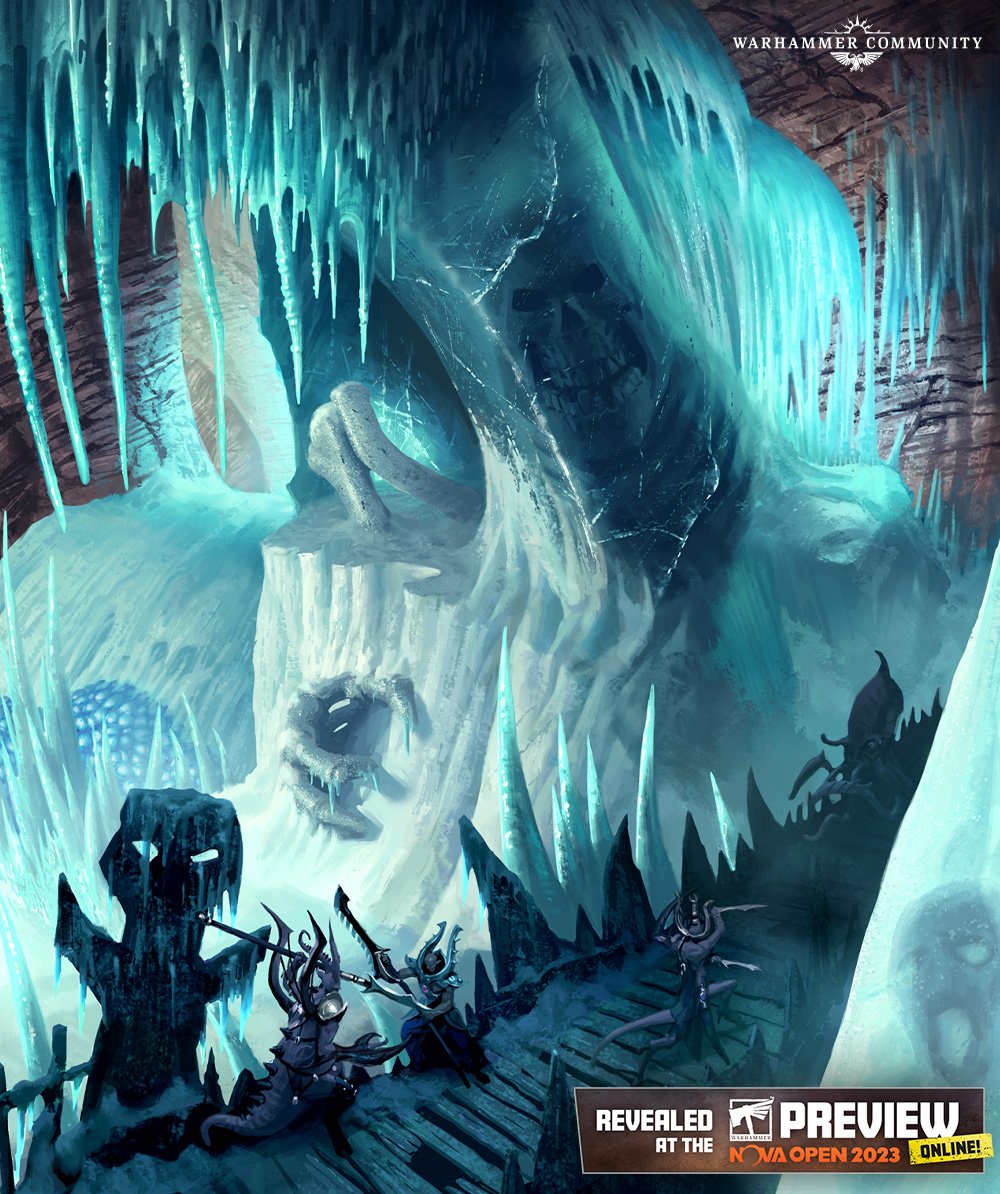
Intro
Alright everybody, chill. Obligatory pun and reference out of the way (those who don’t get it aren’t missing much), welcome to my first full article for Path to Glory. I must say, on my first readthrough of these cards I was a bit lukewarm, because I was quite ready to give the cold shoulder to gambit spell and wizard synergies. But overall, I think the deck is just really cool and offers some pretty unique effects that will feel very Ice to play. Ok, the puns are actually done now.
Plot card
Plot twist – there isn’t one! While in principle this pleases me, in practice I think I’d be happier if these cards were plot-locked for the sake of championship. Instead, feast your eyes on this lovely lore insert which is quite…atmospheric. (Aman apologies in advance for this scan, but he insists in ends up being better for reading anyways.)
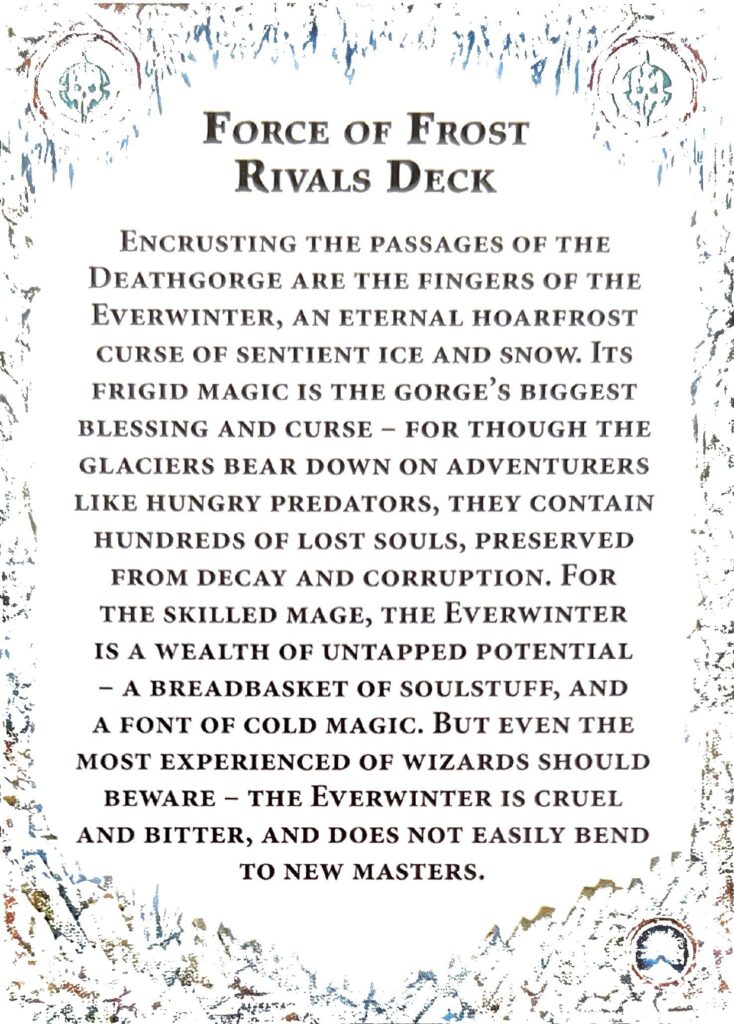
Objectives
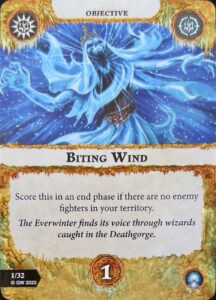
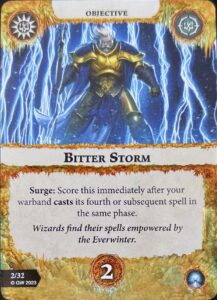
Biting Wind is our first objective, a 1-glory end phase for ending a round with no enemy fighters in your territory. Sad to say, this is a bit mediocre. This condition is typically valued at a bit more glory to make up for the relative difficulty of achieving it; once your opponent knows you have this, they shouldn’t struggle to deny it unless you can table them. This deck does have some extra tools to assist in achieving this but I’m not sure its reliable enough to take for just 1-glory, especially in a world where flying or ‘teleport’ gambits are common among a number of what I’d class as higher tier warbands. In short, I doubt you ever would ‘double down’ on this effect in championship over something similar that’s worth 2 glory. In nemesis, or for best-of-1 events it gains a bit of steam but so very many warbands and decks favor invading that you really have to be confident in your ability to force enemies out of your territory.
Power ceiling: 1, Consistency: 2, Universality: 1
Bitter Storm is very familiar – Domitan’s Stormcoven has this exact card in-faction, and it was recently restricted. I have concerns about the existence of this card, as functionally it gives an R slot back to Domitan in championship, or permits him to double down on passively casting as much as possible even harder. It’s also a very easy grab for Stormsire and Ephilim. In nemesis this is of course rather more limited as it’s a bit reliant on your warband’s native ability to cast spells, but a 2 glory surge with an achievable condition should never be counted out. Most dangerously, this sort of surge can potentially be scored with minimal risk/interaction with the enemy for warbands with access to spell actions or range-agnostic spell gambits. In short, although it does require a fairly significant investment in wizards/spell gambits, it pays off.
Power ceiling: 3, Consistency: 2, Universality: 1
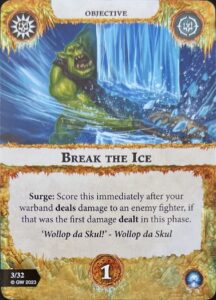
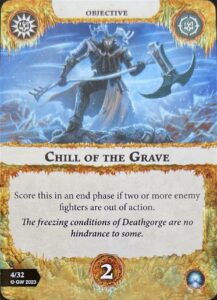
Break the Ice is a 1-glory surge, for damaging an enemy fighter (if its the first damage dealt in this phase). I do not love this, for several reasons. First of all, this sort of surge is deceptively dependent on dice results. First, you will likely struggle to score this if you are not going first in a round, and second, you still have to actually hit an attack. You can of course also score this via ping damage from a gambit, but its simply not reliable to bank on dealing damage first. Additionally, the window for this really only happens once per round (not necessarily in the first activation/power step, but often that will be the case), so drawing into this surge can leave you bricked as you don’t get another chance to score it until the next round. I’ll give it a bit of a point for being hard to deliberately deny (although its essentially what both players should already be trying to do frequently anyway), and being pretty ubiquitous (every warband can/does do this)
Power ceiling: 1, Consistency: 1, Universality: 3
Chill of the grave is a 2-glory end phase objective , requiring 2 or more enemy fighters to be out of action. This is an end phase a lot of warbands have wanted for a very long time; in fact, I think its a bit above-par. Similar objectives tend to either require 3+ enemies OOA or have an additional restriction such as that both must’ve been taken OOA in the same round. Typically we’ve seen that 2-glory end phases requring 3+ enemies out of action are just a bit too difficult as frequently they can’t be scored until round 3 and become quite difficult against more elite warbands. However, at the “2-for-2” bar its really incredibly good. My concern here is that this sort of end phases further punishes larger warbands because they can frequently lose 2 fighters in the first round and even more elite warbands can lose 2 fighters by the end of the second round. Most importantly, unlike many other end phases requiring enemies to be out of action, there isn’t really a matchup where this is too hard; even the most elite 3 fighter bands should routinely lose 2 fighters.
Power ceiling: 2, Consistency: 3, Universality: 3
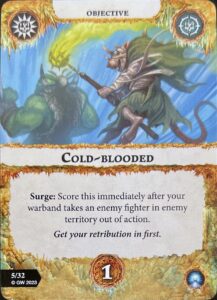

Cold-blooded is a 1-glory surge for taking an enemy fighter in enemy territory out of action. As kill surges go, its not horrendous, because it doesn’t care HOW you take the enemy out of action, nor when, and no matter how aggressive enemies are, there is still at least some portion of a game where they are going to be in their own territory. That said, its a kill surge, and I do not tend to rate those very highly. In particular, the rest of this deck seems to favor a more defensive approach, while this pushes you more to engage with the enemy (and for warbands with lower ranges/lacking sufficient pings, demanding you go forward into enemy territory).
Power ceiling: 1, Consistency, 2, Universality: 2
Cold of the void is a 2-glory end phase for each surviving fighter (friend and foe) not being adjacent to any other fighter. This was a very potent card all the way back in season 1 ([![]() Alone in the Darkness]
Alone in the Darkness]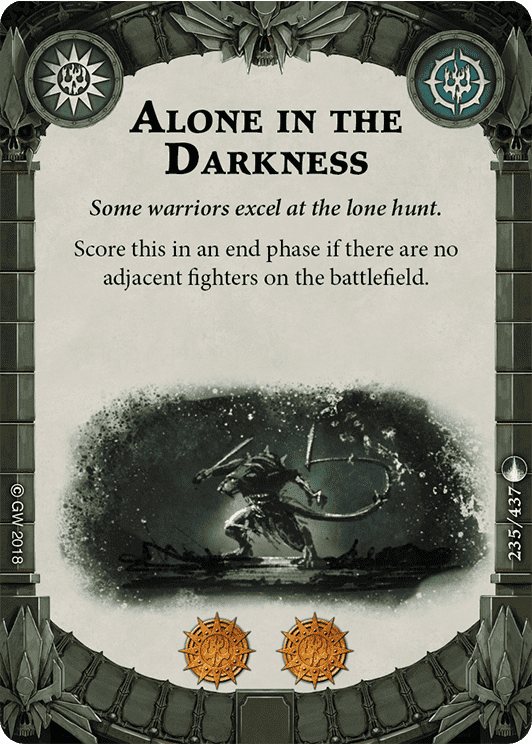 ), and while it isn’t quite what it was (in part because of the loss of many [
), and while it isn’t quite what it was (in part because of the loss of many [![]() Distraction]
Distraction]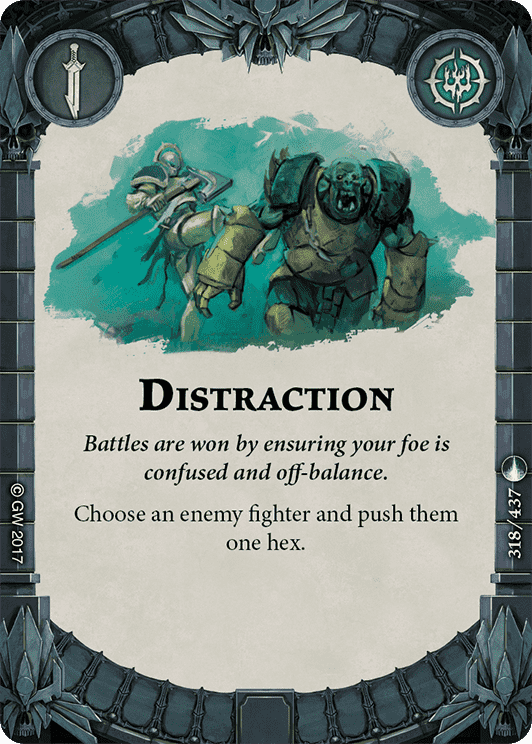 and similar effects to help enforce scoring it), its still a strong return on investment, especially for elite warbands. However, it does require a certain playstyle and commitment to enforcing it; Elathain’s Soulraid, for example, have this as a faction card and yet rarely use it. It isn’t especially difficult to deny via gambit, but the same can be said for enforcing it via gambit. Having this as a universal card again for warbands that are better able to use it (especially defensive, elite warbands) makes me very happy.
and similar effects to help enforce scoring it), its still a strong return on investment, especially for elite warbands. However, it does require a certain playstyle and commitment to enforcing it; Elathain’s Soulraid, for example, have this as a faction card and yet rarely use it. It isn’t especially difficult to deny via gambit, but the same can be said for enforcing it via gambit. Having this as a universal card again for warbands that are better able to use it (especially defensive, elite warbands) makes me very happy.
Power ceiling: 2, Consistency: 2, Universality: 2
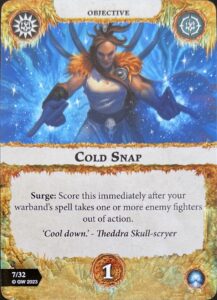
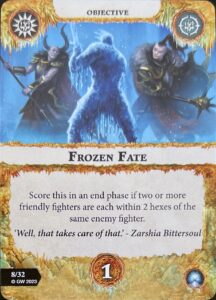
Cold Snap is a 1-glory surge objective for taking one or more enemy fighters out of action with a spell. Again, kill surges aren’t my favorite, but this one thankfully does not require it to be a spell attack action, only a spell. This is essentially what a fair/unrestricted version of [![]() Sudden Demise]
Sudden Demise]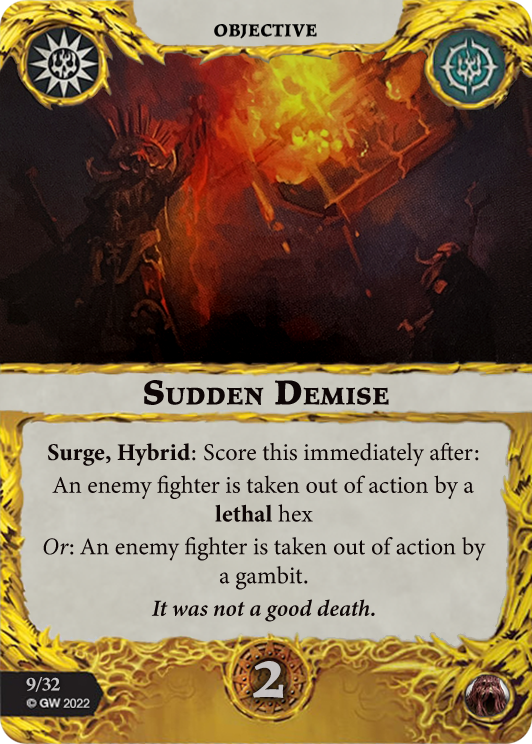 would look like. While you may think the previous surge from this list (Cold-blooded) offered more flexibility because it didn’t care how the enemy was taken OOA, I value positional flexibility more than the option to use a (non-spell) attack action/gambit to score this. However, it does of course limit your warband and deckbuilding options to those with spells and wizards.
would look like. While you may think the previous surge from this list (Cold-blooded) offered more flexibility because it didn’t care how the enemy was taken OOA, I value positional flexibility more than the option to use a (non-spell) attack action/gambit to score this. However, it does of course limit your warband and deckbuilding options to those with spells and wizards.
Power ceiling: 2, Consistency: 2, Universality: 1
Frozen Fate is a 1-glory end phase requiring 2 or more friendly fighters be within 2 hexes of the same enemy fighter. This is a condition that I find is frequently far easier than it sounds. This is also a reprint of a relatively solid faction objective from Elathain’s Soulraid. An important thing to note here (especially as we move into the Deathgorge and its new boards and tokens) is that when measuring distances between fighters, while you do not count paths through incomplete hexes, you do count through blocked hexes. So for example, if an enemy fighter and a friendly fighter are adjacent to opposite sides of a blocked hex, they are still within 2 hexes of each other. For warbands with pushes, or an aggressive gameplan, this is frequently going to be very reliable. However, it does require you to leave the enemy fighter alive and keep at least 2 friendly fighters alive, as well as being vulnerable to disruption via enemy pushes. Since not everyone has spinefin, it does require a bit more effort than I’d want for an end phase in championship. From a nemesis perspective, however, I feel many warbands can make good use of this.
Power ceiling: 1, Consistency: 2, Universality: 2
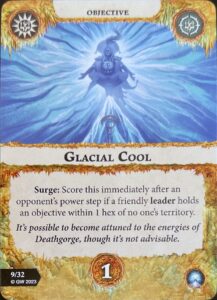
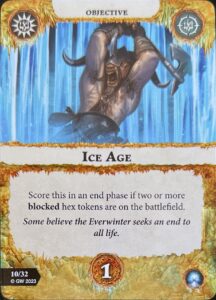
Glacial Cool is another 1-glory surge, scored after an opponent’s power step, if a friendly leader is holding an objective within 1 hex of no one’s territory. I like this scoring window and I like surges for holding objectives. I think this would be an exceptional surge, but for the caveat that it must be your leader and the token must be relatively exposed. That said, there are still lots of ways to “safely” score this, and from a championship perspective because this is scored after a power step and not an activation it can be safely snagged via cards like [![]() Localised Quake]
Localised Quake]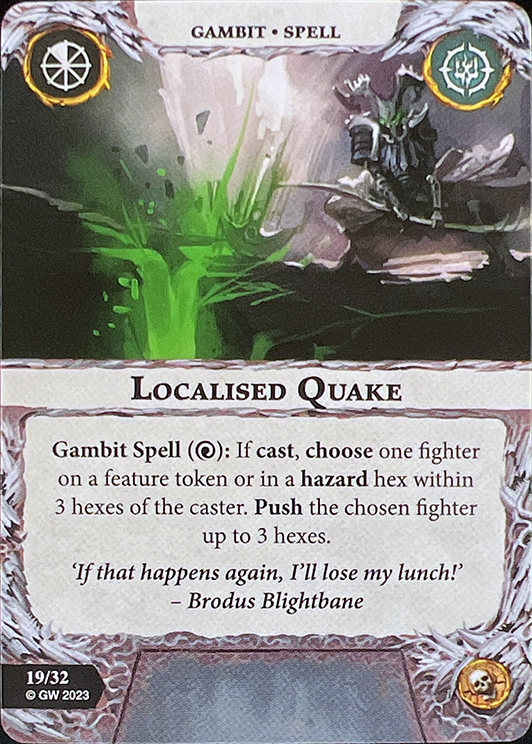 , slinking in there, or even just a [
, slinking in there, or even just a [![]() Sidestep]
Sidestep]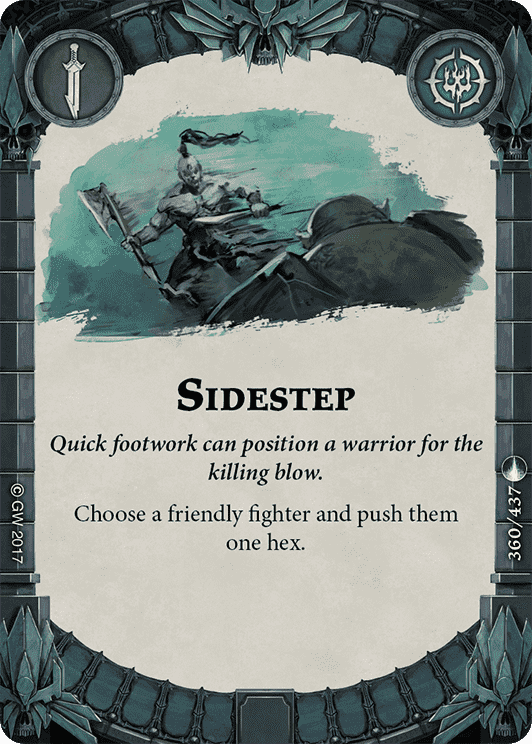 . Even in nemesis, many warbands have access to push tech that could make this safer. Still, you can’t score this if your leader is out of action and exposing your leader at the wrong moment can be a mistake. Additionally, many warbands simply fall apart if their leader is taken out of action and they cannot afford even a calculated (ha!) risk such as this. On the whole, though, its very achievable and the difficulty comes in doing so at the right moment rather than actually scoring it.
. Even in nemesis, many warbands have access to push tech that could make this safer. Still, you can’t score this if your leader is out of action and exposing your leader at the wrong moment can be a mistake. Additionally, many warbands simply fall apart if their leader is taken out of action and they cannot afford even a calculated (ha!) risk such as this. On the whole, though, its very achievable and the difficulty comes in doing so at the right moment rather than actually scoring it.
Power ceiling: 2, Consistency: 2, Universality: 2
Ice Age is a 1-glory end phase scored if 2 or more blocked hex tokens are on the battlefield. For those who didn’t already know, in Deathgorge, the two extra feature tokens that aren’t objectives flip between cover sides, and blocked sides. As we will see below, a number of cards in this deck permit one to place available feature tokens down, and in championship the extra token placed by fearsome fortress’s plot card can likewise be placed as a blocked hex. Additionally, the plunder reaction can now work to place a blocked hex token, so this is scoreable without any card support. However, it can be disrupted by your opponent placing a card with the blocked side down, or by flipping a blocked hex token. Overall, it’s probably going to happen quite often for a while until people adapt to it, but its still not as easy as it could be because some combination of two plunder reactions and/or gambits to place tokens have to come out to score it.
Power ceiling: 1, Consistency: 2, Universality: 3
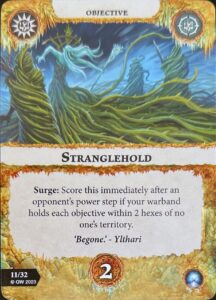
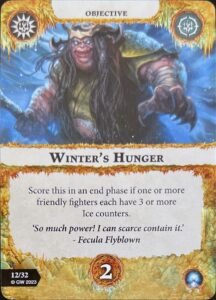
Stranglehold is a 2-glory surge, scored after an opponent’s power step, if you hold each objective that is within 2 hexes of no one’s territory. While I’m happy to see another HO surge, especially a 2-glory one, this is a deceptively difficult condition. Depending on the board set-up, within 2 hexes of no-ones territory can be a truly massive area, that in the worst case could have as many as 4 objectives present after set-up on a full-frontal, and frequently could have 3 objectives required even with a maximum offset. The best case, of course, is a longboard, where there could be as little as just 1 objective. The payoff here is quite good, and if you can (via set-up or token positioning shenanigans) score this by holding less than 3 objectives its quite potent. However, if you have to hold 3 to score this its strictly worse than many similar “surge-premacy” objectives (as I call them) because it requires a particular 3 objectives, and holding 4 objectives at once is a nigh-impossible task. Additional considerations are the viability of delving some or all of the objectives in question, made more difficult by the Deathgorge rules change that limits delving to once per player per power step, full stop. Overall, I’m excited to play with this card, and I think it does create interesting choices during set-up as people who may want to secure just 2 safe objectives in their territory for Claim the Prize may have to risk placing one further forward to make this more difficult for you, or suffer a 3rd objective in their territory. In any case, playing for this requires a commitment to holding the mid-board so its hard to line this up with purely aggro or defensive plans.
Power ceiling: 3, Consistency: 2, Universality: 1
Winter’s Hunger is a 2-glory end phase for one or more friendly fighters each having 3 or more Ice counters. These sort of objectives are always quite hard to evaluate because they are really contingent on a number of other cards (which frequently makes them bad, unless those other cards happen to be amazing on their own). In this case, you’ll have to read on to properly understand my rating for this. Personally I think this is fine for nemesis, because as you’ll see ice counters come on cards that we A) quite like to have in general and B) can provide some resilience to the fighter amassing the counters, which helps alleviate the eggs and basket situation that otherwise arises.
Power ceiling: 2, Consistency: 2, Universality: 2
Our Favorites:
- George: Stranglehold
- Aman: Bitter Storm
- Zach: Frozen Fate
- Mark: Chill of the Grave
Gambits
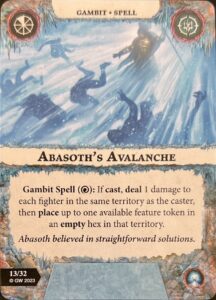
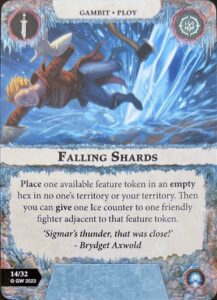
Abasoth’s Avalanche is up first as a gambit spell that casts on a single ‘focus’ (swirl) result; if cast, it deals 1 damage to each (note the lack of the word ‘other’ here) fighter in the same territory as the caster and permits you to place up to one available feature token in an empty hex in that territory. As pings go, this one is absolutely MASSIVE; it does not choose (and so doesn’t require LoS), has a range of up to a whole board, and hits multiple fighters. As if that wasn’t enough it also lets you plop down a token (which could be a blocked token to, say, protect your wizard). The drawbacks, however, are also significant: it will damage the wizard casting it, and for maximum value said wizard has to be in a territory with many enemies and few-to-zero friendly fighters. Still, the reward could be worth the risk, especially in championship where you could access a large number of tools to reposition your wizard into another territory during the power step or follow up on these pings.
Power ceiling: 3, Consistency: 2, Universality: 1
Falling Shards is a gambit, placing one available feature token in an empty hex in your territory or in no one’s territory. After you place the token, you may give one Ice counter to one friendly fighter adjacent to the token. So right away we see some cards that support two of the iffier/more card dependent objectives up above. This gambit is solid strictly for the defensive possibilities raised by placing a blocked hex token, but it really is gonna be a bit of a package deal with other Ice counter synergies. Additionally, because there is a limit to the number of available feature tokens, you can end up with this card becoming unplayable, so that is also a risk when including it. The similar cards in Daring Delvers still provided options to support the exploration mechanic even if you couldn’t use them to place a token; if there are no available tokens, this is simply unplayable.
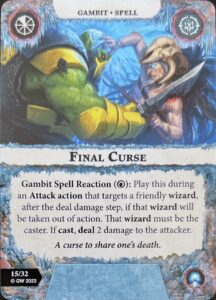
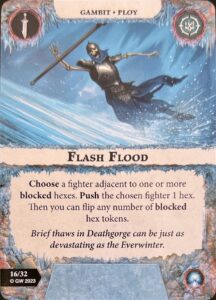
Final Curse is a spell gambit reaction, cast on a single focus (swirl) that you can use during an attack action targeting a friendly wizard after the deal damage step if that wizard would be taken out of action. That wizard must be the caster, and this spell deals 2 damage to the attacker. This is a potent, and impressive, countermeasure. While you’re never happy for your wizard to die, and the most powerful situation for this card is once its been used once and your opponent is now wary that you have it, its still got a higher ceiling than many similar gambit reactions and decent reliability – for level 2 wizards (which, as you’ll soon see, you will almost always have if you are bringing this deck) a single focus casts 75% of the time. Add a re-roll, and it casts 87.5% of the time. For the special case of Ephilim, a level 3 wizard also casts this 87.5% of the time, and adding a re-roll to them improves that to 93.75. Domitan, on the other hand, can use an upgrade to change this to cast on channel (lightning), so for a level 2 wizard it will go off 88.88% of the time; add a re-roll and it improves to 96.29% cast rate. Math aside, this can be a fairly reliable deterrent, and most irritatingly, it does not have a range or position requirement – the only way to kill a wizard and not trigger this is via gambit.
The biggest drawback here is that you obviously can’t cast this just when you want, which makes it hard to count on for your objectives that may want you to cast spells, and so you may frequently have to choose between discarding this to see more of your deck or holding it so you can ultimately use it but limiting how many cards you can cycle through.
Power ceiling: 2, Consistency: 2, Universality: 1
Flash Flood is exactly the gambit tech I mentioned earlier that could counter blocked hex tokens. It’s also reasonably flexible with a number of board choices because even if you’ve not placed any blocked hex tokens it can still act as a sidestep or distraction via printed blocked hexes. Flipping opponent’s blocked hexes is also quite strong since it is difficult without specific cards to flip them back up from cover. However, as the rest of this deck synergizes so strongly with blocked hexes, you may only rarely use the second effect, although I’m certain it may be an effective gotcha to get off an attack from a previously-safe position. It is very important to note that the gambit does not have the word ‘friendly’ so you can use this to throw enemies near blocked hexes around also.
Power ceiling: 2, consistency: 2, Universality: 3
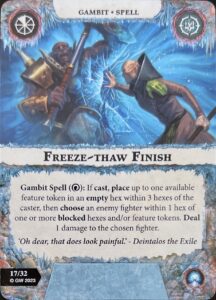
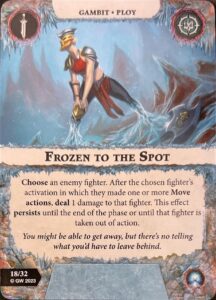
Freeze-Thaw Finish is yet another spell gambit, cast on a focus (swirl) – it places up to one feature token in an empty hex within 3 of the caster, then chooses an enemy within 1 of a blocked hex or feature token and deals 1 damage to them. First things first, important to note that you do not need to place a feature token to cast the spell, the enemy you choose can be adjacent to ANY blocked hex and/or feature token, not just the one you (may have) placed, and that because it chooses an enemy you must have LoS to them. Still, ‘within 1 of a feature token’ and unlimited range is a very flexible and scary ping. The casting math I listed above is also applicable here. This is an absolutely terrifying ping and for a “more difficult” cast, it is even better than stir the nest thanks to longer range and more flexible positioning requirements.
Power ceiling: 3, Consistency: 3, Universality: 1
Frozen to the Spot is a gambit that lets you choose an enemy fighter and deal 1 damage to them after any activation where they make a move action. This does persist until the end of the phase, or the chosen fighter is out of action, but there are several caveats. Firstly, this does not deal damage for movement actions outside of reactions, which currently we see a lot of thanks in particular to the Voidcursed Thralls deck. Second, this sort of effect may seem powerful but in practice it lets your opponent decide whether the ping is worth the move action. Of course you can create situations where it is truly a catch-22 for your opponent but that is more work than it may actually seem at first glance. It’s not terrible but it won’t stop your opponent moving if they need to stand on a token and it won’t make them take a damage if you need a ping to finish them off.
Power ceiling: 2, Consistency: 1, Universality: 3
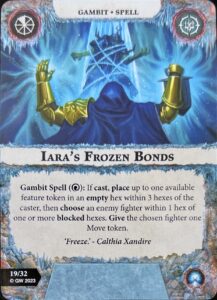
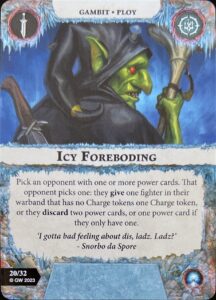
Iara’s Frozen Bonds is a spell gambit, cast on a focus (swirl) that places up to one available feature token within 3 hexes of the caster, then chooses an enemy fighter within 1 of a blocked hex and gives them a move token. To my mind, this is in many ways just strictly worse than Freeze-Thaw Finish as the positioning requirements are steeper (within 1 of a blocked hex, not a blocked hex or feature token) and the payoff is generally lower (a move token rather than a damage). There will be times that this denies a key charge from your opponent, but because it is limited to fighters within 1 of a blocked hex, its much more often that you’ll need to place the blocked token from casting the spell in order to choose the enemy fighter in question, which shortens the range on the effect to enemies 4 hexes away. Also important to note that if you block your own LoS to the fighter in question when placing the blocked hex, in my opinion you shouldn’t be able to choose them, since effects on the card are resolved in the order written. It’s definitely a cool piece of tech but i’m not sure it makes the cut over other spells.
Power Ceiling: 2, Consistency: 2, Universality: 1
Icy Foreboding is an interesting gambit that has some cool payoffs. You pick an opponent with 1+ power cards, then they must pick whether to give a charge counter to a fighter in their warband without any charge tokens, or discard 2 power cards, or just 1 if they only have one. The funny consequence of existing FAQ rulings is that if your opponent has no fighters without charge tokens, they must choose to discard power cards. This has a lot of power at the later stages of the game and the end of a round if your opponent was planning a big power step, maybe to push onto lots of tokens or into position for their end phases. That said, this sort of card requires a high skill ceiling to be used effectively and is best in a very specific timing window that your opponent can play around; in general this sort of card means you always get the effect that is less preferable to you and more preferable to your opponent, but the upside that there are situations where they are compelled to choose the one you want them to makes it stronger. You can also have catch-22 situations when they have just 1 charge token-less fighter but also have power cards they were counting on, but since you don’t know whats in their hand you have to assume they will still make the ‘right’ choice.
Power ceiling: 2, Consistency: 2, Universality: 3
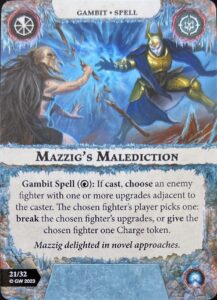
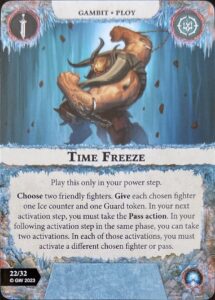
Mazzig’s Malediction is yet another 1 focus spell gambit. This time, you choose an enemy (with at least 1 upgrade) adjacent to the caster and let your opponent choose whether that fighter gains a charge token or breaks all their upgrades. As previously, this sort of effect will usually result in the result you don’t prefer. What makes this most unappealing to me is that it requires you to be adjacent to the target; because of the charge rule, this isn’t necessarily a safe place to be even if they choose the charge token. As before, there will be times you give them a no-win choice but I think that frequently the payoff just won’t be worth the risk.
Power ceiling: 2, Consistency: 1, Universality: 1
Time Freeze is a fairly nutty gambit that to me at least closely resembles [![]() Time Trap]
Time Trap]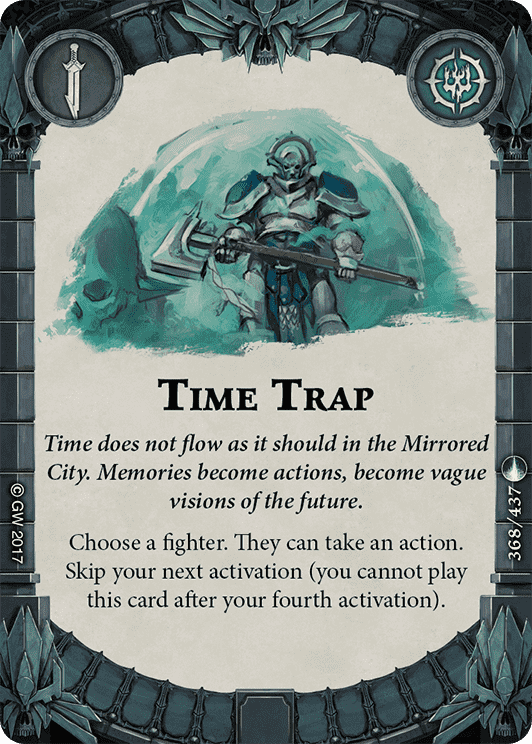 . While it doesn’t let you double up the same fighter going twice, and much like time trap cannot be played in your last activation of a round, it offers some even nuttier synergies. Firstly, handing out 2 guard tokens can help a great deal in surviving the activation you are forced to pass. The ice counters are also nice. Secondly, this grants you two activations, not actions; so it can offer extra windows for surges and reactions “after an activation.” Even though you can only use the two chosen fighters, this is still a great deal of potential power, especially in situations where you don’t mind waiting for your opponent to come towards you, or need to achieve something tricky like knock someone off of a token and then occupy said token, but lack pushes. The obvious counterplay is for your opponent to take advantage of the double turn they get in return and murder one of the fighters you chose, but this can be easier said than done. In effect this is a more balanced time trap because it frontloads the double turn onto your opponent, but even this can be a disruptive thing as they may not have positioned to effectively capitalize on the opportunity.
. While it doesn’t let you double up the same fighter going twice, and much like time trap cannot be played in your last activation of a round, it offers some even nuttier synergies. Firstly, handing out 2 guard tokens can help a great deal in surviving the activation you are forced to pass. The ice counters are also nice. Secondly, this grants you two activations, not actions; so it can offer extra windows for surges and reactions “after an activation.” Even though you can only use the two chosen fighters, this is still a great deal of potential power, especially in situations where you don’t mind waiting for your opponent to come towards you, or need to achieve something tricky like knock someone off of a token and then occupy said token, but lack pushes. The obvious counterplay is for your opponent to take advantage of the double turn they get in return and murder one of the fighters you chose, but this can be easier said than done. In effect this is a more balanced time trap because it frontloads the double turn onto your opponent, but even this can be a disruptive thing as they may not have positioned to effectively capitalize on the opportunity.
Power ceiling: 3, Consistency: 2, Universality: 3
Our Favorites:
- George: Time Freeze
- Aman: Icy Foreboding
- Zach: Time Freeze
- Mark: Flash Flood
Upgrades
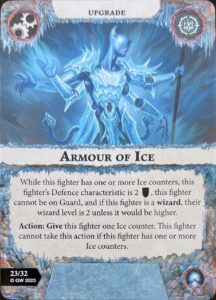
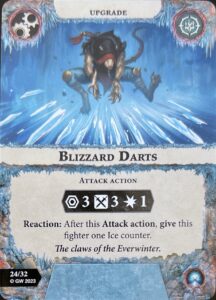
Armour of Ice is our first upgrade, and it showcases an example of an Ice counter payoff. If the upgraded fighter has any Ice counters, their defence characteristic is set to 2 Block, they cannot be on guard, and if they are a wizard, they become Wizard level 2 unless they would be higher. They also gain an action to gain one Ice counter, but can only use this action while they have no Ice counters so it won’t be happening very often. This is a fairly strong card, especially for warbands that have traditionally struggled with employing spell synergies thanks to fragile / level 1 Wizards. Even many level 2 Wizards might not mind exchanging their Dodge defence for 2 Block even at the cost of being on guard. Ephilim and Domitan alike have uses for this, as well as just about any warband with a wizard, since very few wizards reach 2 Block defence.
Power ceiling: 3, Consistency: 2, Universality: 1
Blizzard Darts is an attack action upgrade with a fairly uninspiring statline (Range 3, 3 fury, 1 damage), and a mediocre-on-its-own reaction to gain an Ice counter after making this attack action. On its own this card is meh, since many/most wizard warbands will already have access to Range 3 attacks of some kind or another, but for those that don’t it is nice, and more Ice counter payoffs are yet to come. 2 glory end phase for 3 ice counters may yet be worth building for…
Power ceiling: 1, Consistency: 3, Universality: 2
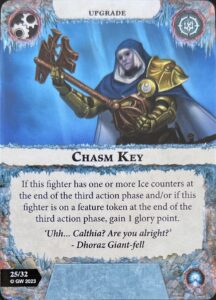
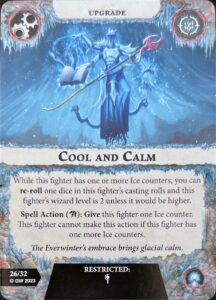
Chasm Key is a type of upgrade I always enjoy. If the upgraded fighter has an Ice counter at the end of the 3rd action phase, or if they are on a feature token at the end of the 3rd action phase, you gain 1 glory. Essentially, it is an extra end phase objective disguised as an upgrade, and potentially telegraphed as such, although there are also times you can sneak this out by putting it on a fighter in the last power step of the game. The alternate condition for an Ice counter meaning your positioning can be very safe makes it almost as good as comparable cards from season 1 like [![]() A Destiny to Meet]
A Destiny to Meet]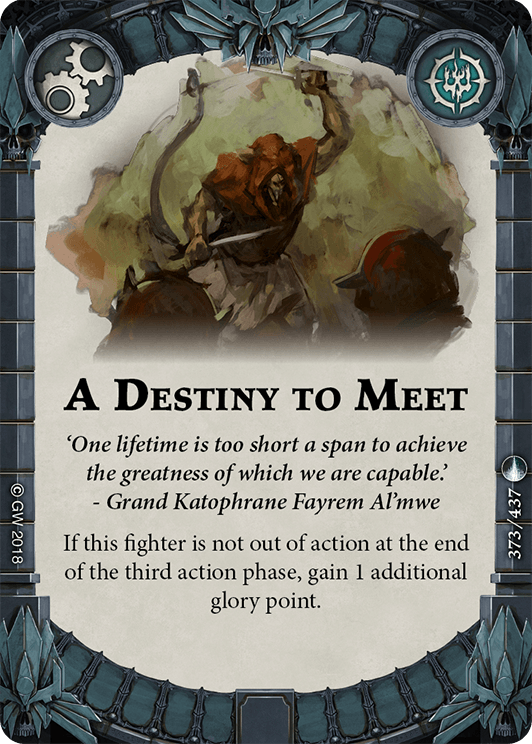 . Obviously while its not quite that reliable, if you’re already bringing Ice counter support it is close enough.
. Obviously while its not quite that reliable, if you’re already bringing Ice counter support it is close enough.
Power ceiling: 2, Consistency: 3, Universality: 3
Cool and Calm is the first wizard-restricted upgrade in this deck, and another Ice counter synergy card. While the upgraded fighter has any Ice counters, you can re-roll on dice in casting rolls, and the fighter’s wizard level is set to 2 unless it would be higher. Additionally, it confers a spell action that casts on a single Channel (lightning) to gain an ice counter, but can only be cast if they don’t already have one or more Ice counters. The Ice counter payoff is far more niche than Armour of Ice, but the spell action is much better than the action on Armour of Ice because it can count towards objectives for casting spells.
Power ceiling: 2, Consistency: 2, Universality: 1
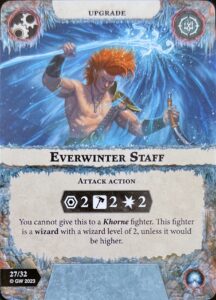
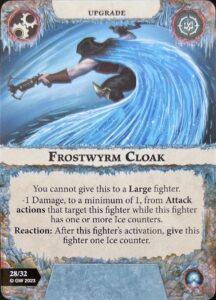
Everwinter Staff is an upgrade I’ve been waiting for for a long time. Firstly, it confers an average attack action – Range 2, 2 Smash, 2 damage. More importantly, you cannot give it to a Khorne fighter, because the upgraded fighter becomes a Wizard with a Wizard level of 2, unless it would be higher. This is, I believe, the first time we’ve gotten an upgrade to fully confer Wizard-hood on a non-wizard fighter, which goes a LONG way to help the many warbands with just a single wizard who have traditionally struggled with committing to a full spell-synergy build thanks to their reliance on one specific fighter. The attack action, while unexceptional, is also not to be scoffed at in the Nemesis setting, where many warbands may be thankful for an attack action to put on a weaker fighter, or a way to confer 2 range to a stronger one. This upgrade manages to hit a lot of niches at once without being overbearing in any of them, it is just a very well-designed card and a welcome one because it provides almost nothing to the currently strongest spell-abusers (Domitan and Ephilim).
Power ceiling: 2, Consistency: 2, Universality: 2
Frostwyrm Cloak, another valued Ice counter payoff/enabler, cannot be given to Large fighters (a fair but disappointing drawback). It confers a -1 damage from attack actions targetting the upgraded fighter while they have one or more Ice counters, and gives a reaction to gain one Ice counter after the upgraded fighter’s activation. This is exactly the sort of resilience I mentioned earlier that can help support Winter’s Hunger, and it doubles as a self-sufficient way to farm the necessary 3 Ice counters. Most warbands don’t have large fighters, and while there is some inherent anti-synergy with another Ice counter upgrade we will see soon, I rate this sort of effect very highly.
Power Ceiling: 3, Consistency: 3, Universality: 3
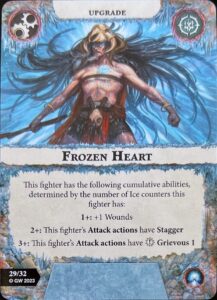
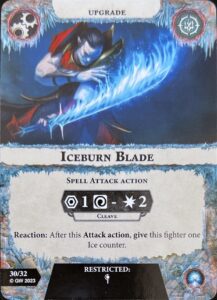
Frozen Heart is the source of the aforementioned anti-synergy. An upgrade with cumulative benefits based on your Ice counters, the most important effects are at 1 Ice counter gaining +1 wound and at 3 Ice counters gaining grievous to all the upgraded fighter’s attack actions. Gaining stagger to your attack actions is nice but relatively unexciting in comparison. It is disappointing that this breaks Frostwyrm Cloak immediately if you try to combine them; perhaps it would be nicer for the +1 wounds to become the benefit for 3+ Ice counters and the other effects each shift up 1 line, but I do like that it is almost immediately a [![]() Great Fortitude]
Great Fortitude]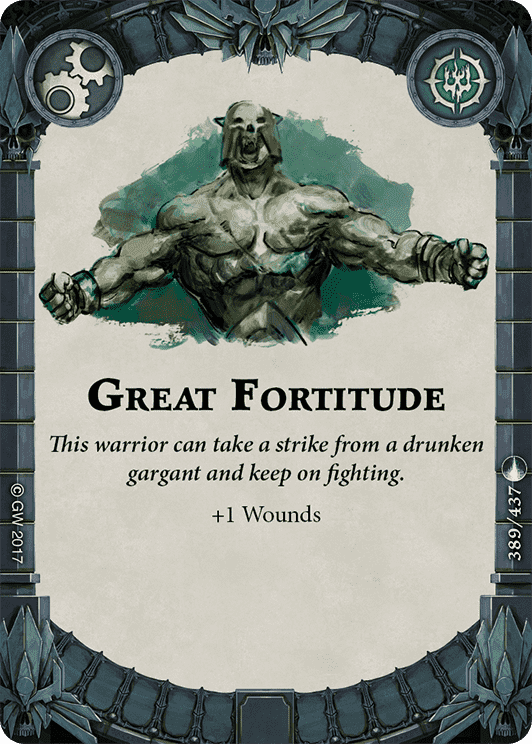 if you’ve included Ice counter tech (which you certainly will, in Nemesis; the difficulty of including counter generation and this card AND great fortitude in champ is also a nice source of balance to potential wound stacking shenanigans, too). Overall, any source of +1 damage is good to see in the Nemesis setting, and from a Champ perspective the relative difficulty of obtaining sources of +damage that are range-agnostic means this card could still find its way into some (memier) builds.
if you’ve included Ice counter tech (which you certainly will, in Nemesis; the difficulty of including counter generation and this card AND great fortitude in champ is also a nice source of balance to potential wound stacking shenanigans, too). Overall, any source of +1 damage is good to see in the Nemesis setting, and from a Champ perspective the relative difficulty of obtaining sources of +damage that are range-agnostic means this card could still find its way into some (memier) builds.
Power ceiling: 3, Consistency: 2, Universality: 3
Iceburn Blade is another wizard-restricted upgrade, an attack action that casts on Focus for 2 damage at Range 1 with cleave. It also has a reaction to gain an Ice counter after the attack action. I recognize that the main appeal of this card is the cleave, but I’m hard-pressed to think of a wizard that really would want this enough to bring the upgrade; Most level 1 Wizards have strictly better non-magical attack actions, and most level 2 Wizards have strictly better spell attack actions. Cleave could certainly be better at times than the common R2 2 Smash 2 Damage staff many wizards seem to have, but I don’t think its enough to warrant an upgrade slot that can only go at range 1 and only on your wizard.
Power ceiling: 1, consistency: 2, Universality: 1
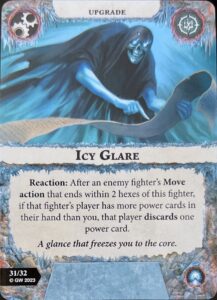
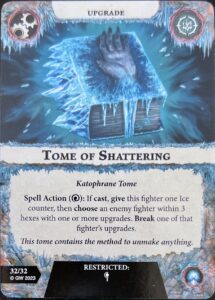
Icy Glare is another deterrent; this upgrade gives you a reaction you can make after an enemy ends a move close to your fighter, if they have more power cards in hand. I don’t have to write the payoff to tell you how A) unlikely that scenario is once your opponent sees this card and B) that if they MUST make that move without playing more cards first, they will still do so. If you could react after your own move actions this would be interesting, if niche, but since your opponent controls whether you get to do this at all, and you have to burn your own power cards fast first to even create the possibility, its just a miss.
Power ceiling: 1, Consistency: 1, Universality: 3
Tome of Shattering confers another spell action. And, its another Katophrane Tome! A cool bonus for true Relic players (if you exist), and a flavor win in my book. The action casts on a Focus (swirl) and then gives the caster an Ice counter before choosing an enemy within 3 hexes and breaking one of their upgrades. Unlike Mazzig’s Malediction, this has a much more flexible positioning requirement and reliably breaks upgrades. However, also unlike Mazzig’s Malediction, this costs an action and only breaks a single upgrade. I think this is still a cool effect as we have seen a number of very potent upgrades in the game right now, and this can still cause an enemy to go out of action by breaking a +1 wounds upgrade. It’s probably too niche for championship but its an interesting option for scoring glory by casting spells and accruing Ice counters. Overall, even though the power level isn’t extremely high, I’m all for this sort of interesting design.
Power ceiling: 2, Consistency: 2, Universality: 1
Our Favorites:
- George: Everwinter Staff
- Aman: Frozen Heart
- Zach: Frostwyrm Cloak
- Mark: Icy Glare
Conclusion
This deck provides a great deal of strength to wizard-based warbands but also to generally defensive and positional play. Additionally, for the first time ever, we have support for single-wizard warbands / level 1 wizard warbands, that doesn’t instantly break the outlier casters. I am very happy that despite some objective support for casting, the deck is not as useless to non-wizard bands as Seismic Shock was, and the upgrade package is similarly potent even for warbands without wizards.
From a nemesis perspective, I think that we will see this deck a great deal with warbands that may have already been using Seismic Shock, as well as for some of the 1-wizard bands that were stuck using Daring Delvers. However, from a championship perspective, this deck is bad news for the meta. In addition to being plotless and providing some extremely powerful token manipulation and ping tech, this deck essentially undoes all the progress made by the previous FAR; Domitan in particular essentially received 2-3 R slots back.
That said, the combo potentials in this deck with pairings such as daring delvers and fearsome fortress look to be very entertaining and I’m very excited to brew with this in championship.
____________________
Written by: George Athanail
Edited by: Aman Khusro
